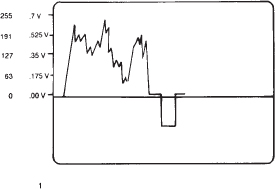Digital technology can solve many video problems.
Analog and Digital
A to D Conversion
Changing the signal from analog voltages into a stream of numbers for digital video takes place in a device known as an analog-to-digital (A to D) converter.
The video signal, from 0 to 100 on the waveform monitor, is approximately 0.7 V strong. You know that the stronger the voltage (0.7), the brighter the glow on the CRT; the weaker the voltage (0.0), the darker the CRT. If we pick a point right in the middle of that range (0.35 V), we could probably figure out that would be in the middle of the gray range. This is sort of what the A to D converter does. The brightness range is divided into 256 possible levels (8-bit processing), with 0.00 V equaling the 0 level and 0. 7 V equaling 255. Midway through the voltage range (0.35 V) would also be midway through the number range (127). As a result each of the 256 numbers represents a separate and distinct voltage and brightness. (Remember, these voltages have been rounded off.)
Sampling and Quantizing
The process of grabbing a piece of the video information and holding it is called sampling; the process of changing that sample into a number is called quantizing. How often a sample is taken is very important. If we sampled the video only a few times a line, we wouldn't get a very accurate picture of what was happening. If you think of the brightness levels along one axis and the sample points along the other axis, you can turn the waveform display into a point-by-point graph that is quite representative. That has been done in the illustration on the right. Imagine how much more accurate it would be with several hundred sampling points instead of a few. The more times we sample a line of video, the more accurate will be our digital representation of that line. Quantizing is the process of turning the individual sample points into numbers.
D to A Conversion
To display a picture, the stream of digital information (numbers) must be converted back to a stream of analog voltages. This is necessary so that the electron gun at the back of the CRT can shoot a stream of electrons to spray the picture onto the phosphors on the face of the CRT. This takes place in the digital-to-analog (D to A) converter. Since each number in the digital stream represents a specific voltage, the D to A converter takes the right amount of voltage from the wall outlet and replaces the numbers with that voltage. As a result, a stream of numbers enters the D to A converter and a stream of voltages leaves it.
1. Breaking the video signal down into numbers.
2. Sampling only a few times a line.
3. Sampling several times a line.



